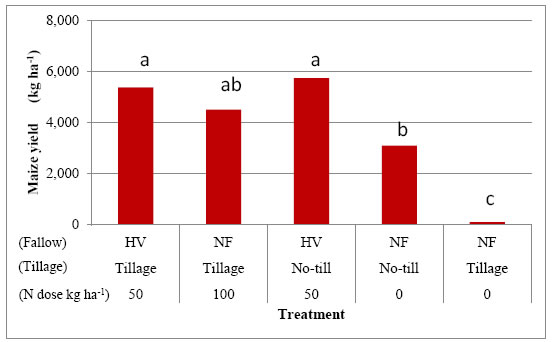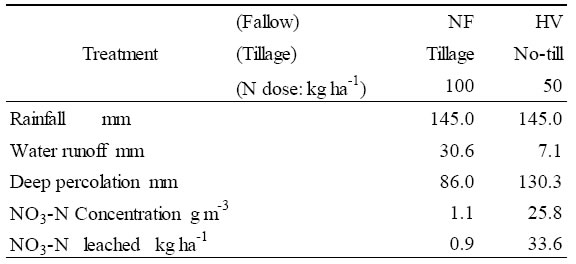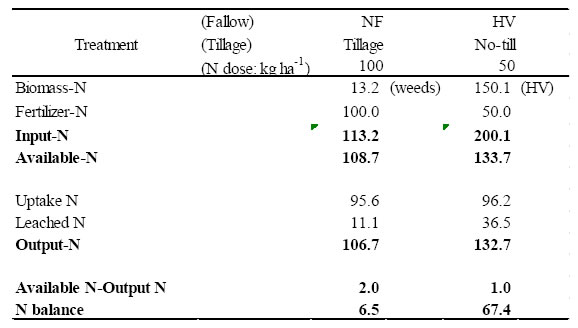Effects of no-till maize cultivation after leguminous hairy vetch cropping on fertilizer saving and nitrogen leaching
Description
No-till cultivation associated with residue mulch after leguminous cropping, has several advantages such as decrease in water runoff and soil erosion, fertilizer saving (JIRCAS research highlight 14). Decrease in water runoff as an advantage, on the contrary, may increase water percolation into the soil; therefore, there is a higher risk to increase nitrogen leaching if nitrate generated due to decomposition of organic matter is not effectively taken by plant. In the present study, we elucidate nitrogen leaching and balance taking into account the relationship between water runoff and water percolation in sloping field when no-till maize cultivation with residue mulch of hairy vetch (Vicia villosa Roth.), which is cropped during the fallow period.
As shown in Figure 1, maize yield with 50 kg dose of nitrogen after hairy vetch cropping, either tilled or no-tilled, is equal to or more than that after fallow (conventional treatment; nitrogen dose: 100 kg ha-1). This results confirm possible nitrogen fertilizer saving. In addition, when zero dose of nitrogen, maize yield after the natural fallow records almost zero yield, while that after hairy vetch cropping obtains 70 % of yield for the conventional cultivation (nitrogen dose: 100 kg ha-1). No-till cultivation after hairy vetch cropping turnovers the residue as mulch. Table 1 shows an example of water movement and nitrogen leaching at main rainfall events. The concentration of nitrate-nitrogen in the percolated water at the hairy vetch treatment increases 23.5 times more than that at the natural fallow treatment, and the amount of percolated water increases only 1.5 times, resulting 37 times of the amount of leached nitrogen. This means that increase in nitrogen leaching is mainly due to the increase in the concentration of nitrate-nitrogen, while the effect of increase in percolation, which is the result of no-till cultivation associated with the residue mulch, is limited. Available nitrogen provided (total amount of nitrogen derived from fertilizer, hairy vetch, and soil) is almost equal to the sum of the amount of nitrogen taken up by maize and that leached. It can be explained that excess nitrogen generated results leaching. Regarding nitrogen balance at the harvest, it is much positively higher for no-till cultivation after hairy vetch cropping than that for conventional cultivation, suggesting that hairy vetch cropping increases soil fertility in sustainable way. It is noted that nitrate-nitrogen output associated with water runoff is not considered in nitrogen balance since it was not detected in the runoff water.
This cropping system shows advantages such as decrease in water runoff, fertilizer saving as described. Therefore, it is expected to be adopted in regions where rainfall is limited, but with high rainfall intensity, and where dose of fertilizer application is limited. Excess turnover of biomass into the soil, however, have a risk of ground water pollution due to nitrogen leaching as shown in the present study. This requires considering quantitative relationship of the amount between fertilized nitrogen and hairy vetch derived one in order to adjust the dose of nitrogen fertilizer.
The present study is conducted at sloping fields (2°, 3.5°, 5.0° in slope gradient, 14 m long), one of the open research facilities, at Japan International Research Center for Agricultural Sciences (JIRCAS), Tropical Agriculture Research Front (TARF), Ishigaki Island, Okinawa prefecture, Japan.
Figure, table
-
Figure 1 Effects of the treatment combination on maize yield. HV: hairy vetch cropping during fallow period, NF: natural fallow Different alphabets indicate significantly different at 5%.
-
Table 1 Example of water runoff and percolation into the soil during a main rain event (Slope gradient: 5°, 27-28 days after planting)
Note: Percolated water was collected by a lysimeter installed at 60 cm deep.HV: hairy vetch cropping during fallow period, NF: natural fallow
-
Table 2 Nitrogen balance at the maize cropping (kg ha-1)
- Affiliation
-
Japan International Research Center for Agricultural Sciences Tropical Agriculture Research Front
- Classification
-
Administration B
- Program name
- Term of research
-
FY 2010 (FY 2006-FY 2010)
- Responsible researcher
-
Nagumo Fujio ( Crop, Livestock and Environment Division )
KAKEN Researcher No.: 20399372Nakamura Ken ( National Institute for Agro-Environmental Sciences )
- ほか
- Publication, etc.
-
https://doi.org/10.1080/00380768.2013.771539
Nagumo, F. et al. (2013) Soil Sci. Plant Nutr., 59: 249-261
- Japanese PDF
-
2013_A05_A3_ja.pdf207.97 KB
2013_A05_A4_ja.pdf352.41 KB
- English PDF
-
2013_A05_A3_en.pdf107.62 KB
2013_A05_A4_en.pdf168.64 KB
- Poster PDF
-
2013_A05_poster.pdf285.74 KB



